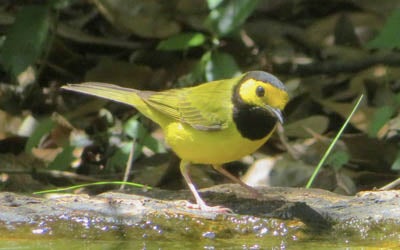Major: Earth Science and Ecology and Evolutionary Biology
Research Advisor: Laurence Yeung
After collecting the hooded warbler feathers, undergraduate researcher Samiksha Deme '21, a sophomore at Will Rice College, cleans them and prepares them for the elemental analyzer. The elemental analyzer burns each feather, releasing oxygen and hydrogen gasses to be analyzed by weight — determining the feather's unique composition of oxygen and hydrogen isotopes.
Deme's work in the lab of Laurence Yeung; assistant professor of earth, environmental and planetary sciences; is characteristic of isotope tracking in rocks, except she analyzes isotopes in bird feathers. This earth science approach helps address a perennial problem in bird ecology: how can we collect more holistic data on organisms, their environment and the feedback between them?
A collaboration between Yeung and Cin-Ty Lee, professor of earth, environmental and planetary sciences and an avid birder, tracking isotopes in bird feathers can reveal many layers of information about a bird's life and changes in their environment: where they lived, what they ate, what they were doing and how they migrated. As it is with humans and our hair, when birds are exposed to different food, climate and environment, unique isotopic signatures are left in their feathers. When well preserved, those signatures are indelible. To researchers like Deme, the signatures are waiting to be discerned, acting as evidence of the relationship between changes in the earth's environment and the evolution of avian migration patterns.

Starting out as an ecology and evolutionary biology major, Deme's first interest was in understanding the evolution of species and of their behavior. Later, she became specifically interested in how rare isotopes allowed insights into the life of different materials and added a major in earth science. After telling Yeung about her interest in the intersection between earth science and evolutionary ecology, Deme was given this pefect project.
It all started with a question, said Deme: "What would we learn if we looked at every feather of a bird, starting at the individual level?" A complete sampling of feathers from one bird would allow the team to reconstruct life histories at the individual level. Detailed information such as the food they ate and the locations they lived in may be more complete when all of the feathers are sampled rather than selecting an isolated feather or two. For example, two feathers that grew at different times on a bird can show changes in the latitude of the bird's flight behavior. Oxygen and hydrogen isotopes of precipitation vary systematically with latitude, so different isotopic compositions can reveal the elevation at which an individual bird flew at a particular developmental stage. In addition to this information, Deme uses complete sampling of individuals to reconstruct moulting events — when birds shed old feathers.
Each time a feather is analyzed for a certain group of isotopes, the sample is completely used up. With a limited amount of feathers, Deme experiments with different methods of isotopic analysis with an eye towards finding the method that yields the most accurate and relevant data. Hydrogen isotopes, for example, provide highly diagnostic analyses and require smaller amounts of feather, but are difficult to process. On the other hand, oxygen isotopes are easy to analyze, but require larger feather samples and offer lower resolution data. Each experiment that Deme conducts informs procedures that will be used in the future. Having shared the research she conducts with her family and friends, Deme finds that, "Everyone has been surprised at how much small things can tell you!"
The next step in Deme's research is to move beyond the birds from within the hedges. She wants to explore other bird samples from the last century. To complement climate data from the last century, feather samples can show how fluctuations in temperature have affected avian diet, migration and distribution. In the face of changing global climate, Deme believes that understanding how climate trends in the past have contributed to the evolution of biological species will be key to predicting future trends. Through her work untangling the mystery of avian evolution and global climate change with Yeung and Lee, Deme continues to shed light into the world of bird feathers.

